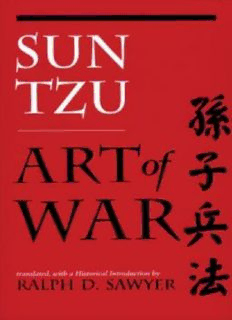
The art of war = [Sunzi bing fa] PDF
Preview The art of war = [Sunzi bing fa]
Table of Contents Other Works by Ralph D. Sawyer Published by Westview Press Title Page Dedication Preface A Note on the Translation and Pronunciation Chronology of Approximate Dynastic Periods Introduction Introduction Sun-tzu - The Art of War In Translation Chapter 1 - Initial Estimations Chapter 2 - Waging War Chapter 3 - Planning Offensives Chapter 4 - Military Disposition Chapter 5 - Strategic Military Power Chapter 6 - Vacuity and Substance Chapter 7 - Military Combat Chapter 8 - Nine Changes Chapter 9 - Maneuvering the Army Chapter 10 - Configurations of Terrain Chapter 11 - Nine Terrains Chapter 12 - Incendiary Attacks Chapter 13 - Employing Spies Tomb Texts and Lost Writings Notes to the General Introduction and Historical Background Notes to the Introduction Notes to the Translation Notes to the Tomb Texts and Lost Writings Selected Bibliography Glossary Index Copyright Page Other Works by Ralph D. Sawyer Published by Westview Press The Complete Art of War The Seven Military Classics of Ancient China Sun Pin Military Methods One Hundred Unorthodox Strategies Battle and Tactics of Chinese Warfare The Tao of Spycraft Intelligence Theory and Practice in Traditional China FORTHCOMING SPRING 2003 The Tao of War In memory of three who forged their own paths: John, Ralph, and Chad Preface RECENT DECADES have witnessed explosive growth in American and European interest in the Far East. Books and articles about China have enjoyed popularity since the 1970s; those on Japan, especially on Japanese management practices, have proliferated since the early 1980s; and those focusing on business in terms of “corporate warfare” and theories of strategy, including Asian practices and their underlying philosophies, retain currency. The writings of Musashi, the famous Japanese swordsman, and Sun-tzu, the ancient Chinese military theorist, have been repeatedly translated, investigated, and discussed. However, as interesting as they and a few books from the martial arts have proven to be, the vast Chinese military corpus—despite its historical importance and contemporary significance—remains unknown in the West. Chinese military thought probably originated with neolithic village conflicts four or five thousand years ago, perhaps even as mythologized in the clash of legendary cultural heroes and Sage Emperors. Subsequently, because men were compelled to direct their ingenuity toward combat, weapons were developed, tactics evolved, and power structures arose. Eventually, dominant figures— perhaps clan or lineage chiefs commanding more-warlike peoples—imposed their wills over other groups and widening domains and some groups became significant political powers. At the dawn of the historical age, as preserved in early written materials and revealed by artifacts, frequent, intense clashes were already occurring between these contending forces as they evolved into states and as powerful individuals sought to establish sole rule over the realm and to found dynastic houses. Thereafter the scope of battle expanded; the strength and effectiveness of weapons increased; and military organization, tactics, and technology all developed. Eventually, battlefield lessons and command experience became the focus of conscious study; efforts were made to preserve the insights and avoid the errors of the past; and the science of military tactics and strategy was born. By the second century B.C. China had already passed through a thousand years of almost unremitting conflict and had been brutally unified into a vast, powerful, imperially directed entity. Along the way, skilled commanders appeared, and major battles were fought. Campaigns became interminable, and
Description: